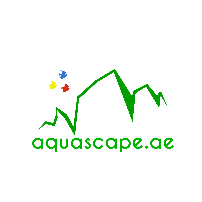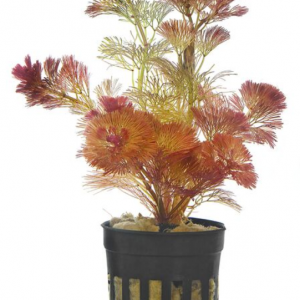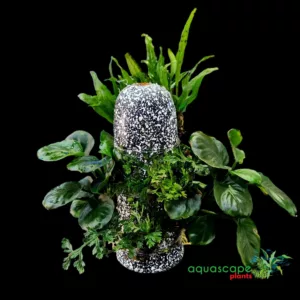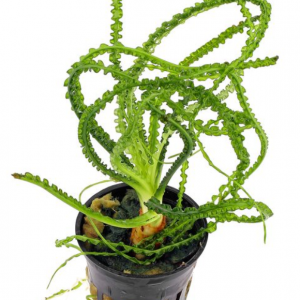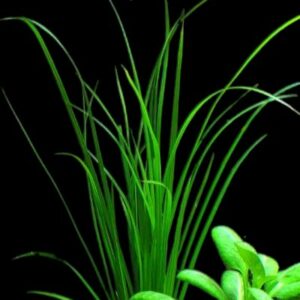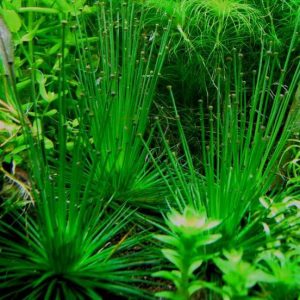Subtotal: د.إ68.15
Potted
Showing 49–72 of 136 results
-
Sold out!Live Plants & Neutrients, Plants, Potted
Bucephalandra Deep Blue
Pot
Bucephalandra “Deep Blue” is a beautiful and hardy aquatic plant commonly used in aquascaping. Here’s how to care for it:
1. Lighting
Moderate to low light levels are sufficient for Bucephalandra.
Too much light can encourage algae growth on its leaves.
2. Water Parameters
Temperature: 22–28°C (72–82°F).
pH: 6.0–7.5, though it can tolerate slightly acidic to neutral conditions.
Hardness: Soft to moderately hard water.
3. Substrate
Bucephalandra can be attached to rocks, driftwood, or other hardscapes using thread or glue.
Avoid burying the rhizome in the substrate, as it may rot.
4. Fertilization
Provide a consistent supply of nutrients through liquid fertilizers or root tabs.
CO₂ supplementation is optional but can promote faster and more vibrant growth.
5. Water Flow
Moderate water flow helps prevent algae buildup and keeps the plant healthy.
6. Maintenance
Prune dead or decaying leaves to prevent algae and maintain aesthetics.
Bucephalandra grows slowly, so regular trimming isn’t necessary.
7. Propagation
Propagate by cutting the rhizome. Ensure each piece has at least one or two leaves.
8. Preventing Algae
Maintain a balanced tank with proper lighting, nutrient levels, and water changes.
Keep algae-eating fish or shrimp, like Amano shrimp or Otocinclus, in the tank.
By following these steps, your Bucephalandra “Deep Blue” should thrive and become a stunning addition to your aquarium.
SKU: n/a -
Live Plants & Neutrients, Plants, Potted
Bucephalandra kedakang on lava rock
Bucephalandra Kedagang on Lava Rock
Bucephalandra Kedagang is a popular aquatic plant belonging to the Araceae family, native to Borneo. It is highly sought after for its striking foliage, which features deep green leaves with a slightly wavy texture and a metallic blue or silver sheen under proper lighting. When grown submerged, it may produce small white or pinkish flowers.
Mounted on lava rock, this plant makes a stunning natural display in aquariums or paludariums. The porous lava rock provides excellent anchorage for the roots while allowing beneficial water flow around the rhizome.
Care Guide
1. Lighting
-
Low to Moderate light is ideal.
-
High light can enhance colors but may encourage algae growth on leaves.
-
Avoid direct, intense lighting to prevent leaf melt.
2. Water Parameters
-
Temperature: 72–82°F (22–28°C)
-
pH: 6.0–7.5 (slightly acidic to neutral preferred)
-
Hardness: Soft to moderately hard water (GH 4–12)
-
Clean, well-oxygenated water is essential to prevent algae.
3. Placement & Flow
-
Attach to lava rock, driftwood, or aquarium hardscape.
-
Can be grown fully submerged or emersed (in paludariums).
-
Prefers gentle to moderate water flow to mimic its natural stream habitat.
4. Fertilization & CO₂
-
Not mandatory, but liquid fertilizers like profito (rich in potassium & micronutrients) promote healthier growth.
-
CO₂ supplementation enhances growth and coloration but is not required.
5. Maintenance
-
Trim old or melting leaves to encourage new growth.
-
Avoid burying the rhizome (roots can attach naturally to the rock).
-
Control algae by maintaining good water quality and avoiding excess light/nutrients.
6. Propagation
-
Cut the rhizome with a sharp blade, ensuring each new piece has at least 2–3 leaves.
-
Attach the new cuttings to another rock or driftwood.
Why Choose Bucephalandra Kedagang on Lava Rock?
✅ Natural look – Lava rock provides a stable, porous base.
✅ Low maintenance – Thrives with minimal care.
✅ Versatile – Works in aquariums, ripariums, and paludariums.
✅ Unique texture & color – Adds depth and contrast to aquascapes.Perfect for nano tanks, shrimp tanks, and biotope setups! 🌿💧
SKU: n/a -
-
Live Plants & Neutrients, Plants, Potted
Cabomba aquatica
Cabomba aquatica
- Gorgeous stem plant from South America
- Light green, filigree leaves
- Especially suited to larger aquariums
The Cabomba aquatica is a gorgeous fine-leafed stem plant from tropical South America. This aquatic plant comes from sunny, fast flowing to calm, acid, very soft waters. There are different forms of this species, e.g. the reddish “Cabomba schwartzii”, however the customary form has light green leaves. The stems of Cabomba aquatica may get more than one meter long and have pairs of up to 9 cm wide, fan-shaped submerged leaves with fine segments. When the shoots reach the water surface, shield-shaped floating leaves and yellow flowers may appear.
In contrast to the winter-hardy Carolina fanwort Cabomba caroliniana, an invasive species in Europe, the tropical Cabomba aquatica is still allowed to be traded in the European Union. For all kinds of aquarium plants, it must be ensured that they do not enter waters and sewage systems. Dispose aquarium plants via the household waste only.Cabomba aquatica is a demanding aquarium plant. Strong lighting, soft, flowing water and CO2 addition are important, as well as macro and micronutrient supply on a regular basis. The optimum temperature range lies between 23 and 27 °C. As well as other stem plants, The Giant Cabomba can be propagated by cuttings, it also develops new shoots at the basis of older stems.
This Cabomba looks best in larger, at least 50 cm high tanks, as a group or larger stand in the background to midground. Its light green, filigree foliage contrasts with darker or red, more coarsely textured plants. In open tanks, also its floating leaves and small yellow flowers offer an interesting sight; they may develop when the stems are allowed to grow along the surface.
Cabomba aquatica is a highly variable fanwort originating from the northern and central parts of South America. There are various colour varieties, the most frequently found in trade form of which is a green plant named giant Cambomba.
C. aquatica has up to 8.5 cm long and 9.5 cm wide submersed leaves parted into a great many fine tips. When the sprouts reach the water surface, on its tip widely oval to roundish, shield-shaped floating leaves may form, as well as yellow, mostly two-fold flowersSKU: n/a -
Sold out!
-
Sold out!Live Plants & Neutrients, Plants for terrarium, Potted
Creeping Jenny or Lysimachia nummularia
Lysimachia nummularia, commonly known as Creeping Jenny or Moneywort, is a versatile and attractive plant that can be grown both in aquariums and in terrestrial environments (e.g., ponds, gardens, or terrariums). It is known for its bright green or golden-yellow leaves and its creeping growth habit. Here’s a detailed care guide to help you grow and maintain this plant:
1. Overview
- Scientific Name: Lysimachia nummularia
- Common Name: Creeping Jenny, Moneywort
- Origin: Europe and North America
- Difficulty Level: Easy
- Growth Rate: Fast
- Light Requirement: Medium to High
- CO2 Requirement: Not required (but beneficial for submerged growth)
2. Tank or Pond Requirements
- Tank Size: Suitable for small to large aquariums (10+ gallons) or outdoor ponds.
- Water Temperature: 60–75°F (15–24°C). It can tolerate slightly cooler or warmer temperatures.
- pH Level: 6.0–7.5 (slightly acidic to neutral).
- Water Hardness: Soft to moderately hard (2–15 dGH).
SKU: n/a -
Plants, Potted
Crinum Calamistratum
- Undemanding plant
- Curvy narrow leaves
- Dark green color
Complete botanical name Crínum calamistrátum Bogner & Heine Family Amaryllidaceae Genus Crinum Difficulty easy Usage Background, Midground, Specimen plant Growth slow pH value 5 – 8 Temperature tolerance 12 – 30°C Carbonate hardness 2 – 12°dKH  SKU: n/a
SKU: n/a -
Live Plants & Neutrients, Plants, Potted
Crinum Natans bulb
Crinum natans is a striking bulb plant native to African rivers and streams. Its long, flowing, ribbon-like leaves add a dramatic touch to planted aquariums. Here’s everything you need to know about this unique aquatic plant.
Common Names: Floating Crinum, African Onion Plant, River Lily
Scientific Name: Crinum natans
Family: Amaryllidaceae
Origin: West and Central Africa (rivers and streams in Nigeria, Cameroon, etc.)Appearance:
-
Leaves: Long, ribbon-like, wavy or crinkled, dark green, can grow up to 4 feet (120 cm) in length.
-
Growth Form: Submerged aquatic plant, but can grow emersed in shallow water.
-
Root System: Bulbous base (similar to an onion), with thick, white roots.
-
Flowers: Rare in aquariums, but produces beautiful white or pink lily-like flowers when grown emersed.
Crinum natans Care Tips
1. Tank Requirements:
-
Tank Size: Minimum 20 gallons (larger is better due to its size).
-
Lighting: Moderate to high (but can adapt to low light, grows slower).
-
Substrate: Nutrient-rich substrate (clay or root tabs recommended).
-
Water Flow: Prefers gentle to moderate flow (mimics its natural river habitat).
2. Water Parameters:
-
Temperature: 72–82°F (22–28°C)
-
pH: 6.0–7.5 (slightly acidic to neutral)
-
Hardness: Soft to moderately hard (2–15 dGH)
3. Planting & Maintenance:
-
Planting: Bury the bulb about halfway into the substrate (do not fully cover it to prevent rot).
-
Fertilization: Benefits from root tabs or liquid fertilizers (iron-rich fertilizers enhance leaf color).
-
Pruning: Remove old, yellowing leaves at the base. New leaves will grow from the center.
-
Growth Rate: Slow to moderate (patience is key).
4. Compatibility:
-
Fish: Safe with most community fish (tetras, gouramis, cichlids).
-
Inverts: Shrimp and snails won’t harm it.
-
Avoid: Plant-nibbling fish (like goldfish or some cichlids).
5. Propagation:
-
Produces bulb offsets (pups) that can be separated and replanted once they develop roots.
-
Rarely flowers underwater but may produce seeds if grown emersed.
Final Notes:
-
Hardy but slow-growing – don’t expect rapid growth.
-
Leaves may melt initially when moved to a new tank but will regrow if the bulb is healthy.
-
Great for midground or background in larger aquariums.
SKU: n/a -
-
Plants, Potted
Cryptocoryne undulatus red
Cryptocoryne undulatus red is a type of aquarium plant commonly known as the “red wendtii” or “red crypt.” It belongs to the genus Cryptocoryne, which consists of various species known for their stunning appearance and ability to thrive in aquatic environments
SKU: n/a -
Live Plants & Neutrients, Plants for terrarium, Plants, Potted
Cryptocoryne wendtii Green Pot
- Robust time-tested Crypt
- Forms dense groups
- Green to slightly brown hues
Cryptocoryne Wendtii Green – A Hardy Aquatic Plant for Stunning Aquascapes
Cryptocoryne Wendtii Green is a popular freshwater aquarium plant, prized for its lush green leaves and low-maintenance care. Native to Sri Lanka, this versatile plant thrives in various water conditions, making it ideal for beginners and experienced aquarists alike.
With its compact growth habit and tolerance for low light, Cryptocoryne Wendtii Green is perfect for foreground to midground placement in aquascapes. It adapts well to CO2-enriched and non-CO2 setups, providing a natural and serene aesthetic to any tank.
Enhance your aquarium’s ecosystem with this hardy, slow-growing plant that offers shelter and grazing spots for fish and invertebrates. Choose Cryptocoryne Wendtii Green for a vibrant and long-lasting underwater display.
SKU: n/a -
Live Plants & Neutrients, Plants, Potted
Cyperus Helferi
Cyperus helferi is a popular aquatic plant species that is native to Thailand in Southeast Asia. It is a relatively new plant in the aquarium hobbyist community and is known for its unique appearance and growth characteristics. This plant is typically found in ponds and slow-flowing water and is one of the few plants from the Cyperaceae family that can grow fully submersed
SKU: n/a -
Live Plants & Neutrients, Plants, Potted
Echinodorus ‘Aquartica’
This compact, green, low-growing Echinodorus cultivar was developed by the plant breeder Christian Iversen from Aquartica company in Denmark. Under aquarium conditions, it forms a spreading rosette of broadly elliptic, medium green leaves with wavy margin. In stark contrast to the many vigorously growing, large swordplants, it is even suited for the foreground and for nano aquariums as it gets only 10-20 cm. Furthermore it grows quite slowly and contents with only moderate light intensity.
This plant is mostly delivered in its emersed (terrestrial) stage, with more roundish, longer stalked leaves. Planted into the aquarium, it will develop its typical submerged growth habit.
Recommendable low-growing Echinodorus cultivar
10-20 cm tall
Medium-green leaves with wavy edge
Also suited for the foreground and nano aquariumsSKU: n/a -
Sold out!Live Plants & Neutrients, Plants, Potted
Echinodorus argentinensis Mother Plant XXXL 80cm high
Echinodorus argentinensis is a species of aquatic plant in the Alismataceae family, native to South America (Argentina, Brazil, Paraguay, and Uruguay). It is a robust, semi-aquatic or aquatic plant often used in ponds and large aquariums due to its impressive size and attractive foliage.
Description:
-
Leaves: Broad, lanceolate to oval, with prominent veining. Mature leaves can grow up to 12-18 inches (30-45 cm) long.
-
Color: Bright to dark green, sometimes with a slightly wavy edge.
-
Growth Form: Rosette-forming, with long petioles (leaf stems) emerging from a central root crown.
-
Size: Can reach up to 20-24 inches (50-60 cm) in height when fully grown.
-
Flowers: Produces tall inflorescences with small white flowers when grown emersed (above water).
-
Root System: Strong, fibrous roots that anchor well in substrate.
Care Tips:
-
Lighting:
-
Moderate to high light is ideal for healthy growth.
-
Can tolerate lower light but may grow more slowly and produce smaller leaves.
-
-
Water Parameters:
-
Temperature: 68-82°F (20-28°C).
-
pH: 6.5-7.5 (slightly acidic to neutral preferred).
-
Hardness: Soft to moderately hard water (2-15 dGH).
-
-
Substrate:
-
Nutrient-rich substrate (such as aquarium soil or clay-based gravel) promotes vigorous growth.
-
Root tabs or liquid fertilizers help if the substrate is inert.
-
-
CO2 & Fertilization:
-
Benefits from CO2 supplementation but can grow well without it.
-
Regular fertilization (iron-rich fertilizers) prevents yellowing leaves.
-
-
Pruning & Maintenance:
-
Remove old, decaying leaves to encourage new growth.
-
Large specimens may need thinning if they overshadow other plants.
-
-
Propagation:
-
Produces adventitious plantlets on flower stalks when grown emersed.
-
Can also be divided by splitting the root crown.
-
Special Considerations:
-
Best suited for larger aquariums or ponds due to its size.
-
Can be grown emersed in paludariums or bog setups, where it may flower.
-
Relatively undemanding but appreciates stable water conditions.
Would you like recommendations for tankmates or compatible plants?
SKU: n/a -
-
Live Plants & Neutrients, Plants, Potted
Echinodorus parviflorus ‘Tropica’
Echinodorus parviflorus ‘Tropica’ from aquascapeplants is a popular aquatic plant in the aquarium hobby, known for its attractive rosette form and relatively easy care requirements. It’s a cultivar of Echinodorus parviflorus, often referred to as the “Black Sword Plant” due to its dark-green to brownish leaves.
SKU: n/a -
Live Plants & Neutrients, Plants, Potted
Echinodorus quadricostatus (Easiest Carpet Plant)
Echinodorus quadricostatus
— also known as the Cuban Broad Leaf Chain Sword — is a fast-growing, foreground aquatic plant prized for its lush, carpet-forming appearance and ease of care. Here’s a detailed breakdown perfect for your aquascaping or product listing needs:
🌱 Botanical Profile
- Scientific Name: Echinodorus quadricostatus (often traded under Helanthium bolivianum ‘Quadricostatus’)
- Family: Alismataceae
- Common Name: Cuban Broad Leaf Chain Sword
- Origin: South America (notably Brazil and surrounding regions)
🌿 Appearance & Growth
- Leaf Color: Light to medium green
- Leaf Shape: Broad, lanceolate leaves with subtle ribbing
- Size: Typically 10–15 cm tall; spreads 15–20 cm wide
- Growth Habit: Forms dense rosettes and spreads via runners
- Growth Rate: Fast, especially under bright lighting
💧 Tank Requirements
Parameter Ideal Range Temperature 22–28 °C (72–82 °F) pH 6.5–7.4 Hardness 4–12 °dGH Lighting Moderate to high Substrate Nutrient-rich or gravel with root tabs 🌾 Propagation
- Method: Produces runners with daughter plants
- Tip: Let runners establish before separating and replanting for best results
🌟 Aquascaping Use
- Placement: Foreground or midground in nano tanks
- Effect: Creates a vibrant, grassy carpet that contrasts beautifully with darker or red plants
- Compatibility: Ideal for community tanks and beginner-friendly setups
SKU: n/a -
Sold out!Live Plants & Neutrients, Plants, Potted
Echinodorus Rose
Echinodorus ‘Red Diamond’ was bred in the Ukraine and is probably a cross between Echinodorus horemanni ‘Red’ and Echinodorus x barthii. The resultant hybrid is an attractive, relatively small plant with ruby-red sword-shaped leaves, 15-25 cm long.
Unlike many other sword plants, Echinodorus ‘Red Diamond’ remains moderate in size (20-30 cm wide rosette), so it is extremely well suited as a solitary plant, even in small aquariums. Increasing the nutrients in the substrate results in more abundant growth, while favourable light conditions promote the formation of the ruby-red leaves.
- Red leaves, dark red nerves
- Narrowly egg-shaped leaves
- Relatively low
- Also suitable for small tanks
Genus Echinodorus Difficulty medium Usage Background, Midground Growth medium pH value 5 – 7 Temperature tolerance 15 – 30°C Carbonate hardness 0 – 21°dKH General hardness 0 – 30°dGH Propagation Proliferating inflorescences, Rhizomteilung Can grow emersed? yes SKU: n/a -
Live Plants & Neutrients, Plants, Plants for terrarium, Potted
Echinodorus vesuvius
Echinodorus vesuvius, also known as the Vesuvius Sword Plant, is a unique and eye-catching aquatic plant. Here’s a detailed description:
Overview
Common Name: Vesuvius Sword Plant Scientific Name: Echinodorus vesuvius (also known as Helanthium bolivianum ‘Vesuvius’) Family: Alismataceae Origin: Hybrid, likely from Singapore
Appearance
Leaves: Narrow, twisted, and spiral-shaped, resembling corkscrew vallisneria Height: Typically grows between 10 to 30 cm (4 to 12 inches) Growth Rate: Fast, especially in nutrient-rich environments
Care Requirements
Lighting: Medium to high intensity CO2: Beneficial but not essential Water Parameters:
- pH: 5.5 to 7.5
- Hardness: Soft to moderately hard water
- Temperature: 21 to 25 °C (70 to 77 °F)
SKU: n/a -
Sold out!Plants, Potted
Eleocharis vivipara Tall hairgrass
The Tall Hairgrass forms hair-thin long leaves. On the leaf tips, adventitious plants are formed. Eleocharis vivipara is ideal for planting higher “meadows” in the back of the aquascape.
Difficulty easy Usage Background, Midground Growth medium pH value 4 – 7 Temperature tolerance 5 – 29°C Carbonate hardness 2 – 5°dKH General hardness 0 – 30°dGH Propagation Proliferating inflorescences, Splitting, cutting off daughter plants SKU: n/a

 FLOURISH IRON 250ML
FLOURISH IRON 250ML 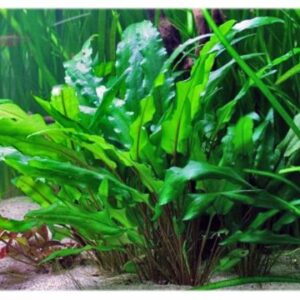 Cryptocoryne wendtii Green Pot
Cryptocoryne wendtii Green Pot 